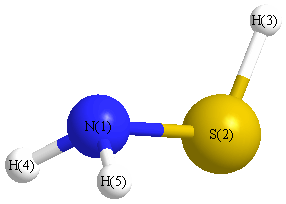Jump to
S1C2
Energy calculated at CCSD(T)/6-31+G**
| | hartrees |
|---|
| Energy at 0K | -454.035317 |
| Energy at 298.15K | -454.039086 |
| HF Energy | -453.689095 |
| Nuclear repulsion energy | 57.273203 |
The energy at 298.15K was derived from the energy at 0K
and an integrated heat capacity that used the calculated vibrational frequencies.
Vibrational Frequencies calculated at CCSD(T)/6-31+G**
| Mode Number |
Symmetry |
Frequency
(cm-1) |
Scaled Frequency
(cm-1) |
IR Intensities
(km mol-1) |
Raman Act
(Å4/u) |
Dep P |
Dep U |
|---|
| 1 |
A' |
3568 |
3424 |
|
|
|
|
| 2 |
A' |
2737 |
2627 |
|
|
|
|
| 3 |
A' |
1677 |
1609 |
|
|
|
|
| 4 |
A' |
1061 |
1018 |
|
|
|
|
| 5 |
A' |
907 |
871 |
|
|
|
|
| 6 |
A' |
672 |
645 |
|
|
|
|
| 7 |
A" |
3674 |
3525 |
|
|
|
|
| 8 |
A" |
1150 |
1103 |
|
|
|
|
| 9 |
A" |
435 |
418 |
|
|
|
|
Unscaled Zero Point Vibrational Energy (zpe) 7940.4 cm
-1
Scaled (by 0.9596) Zero Point Vibrational Energy (zpe) 7619.6 cm
-1
See section
III.C.1 List or set vibrational scaling factors
to change the scale factors used here.
See section
III.C.2
Calculate a vibrational scaling factor for a given set of molecules
to determine the least squares best scaling factor.
Geometric Data calculated at CCSD(T)/6-31+G**
Point Group is Cs
Cartesians (Å)
| Atom |
x (Å) |
y (Å) |
z (Å) |
|---|
| N1 |
0.015 |
1.119 |
0.000 |
| S2 |
0.015 |
-0.625 |
0.000 |
| H3 |
-1.315 |
-0.765 |
0.000 |
| H4 |
0.490 |
1.467 |
0.825 |
| H5 |
0.490 |
1.467 |
-0.825 |
Atom - Atom Distances (Å)
| |
N1 |
S2 |
H3 |
H4 |
H5 |
| N1 | | 1.7439 | 2.3060 | 1.0139 | 1.0139 |
S2 | 1.7439 | | 1.3372 | 2.2984 | 2.2984 | H3 | 2.3060 | 1.3372 | | 2.9869 | 2.9869 | H4 | 1.0139 | 2.2984 | 2.9869 | | 1.6502 | H5 | 1.0139 | 2.2984 | 2.9869 | 1.6502 | |
 More geometry information
More geometry information
Calculated Bond Angles
| atom1 |
atom2 |
atom3 |
angle |
|
atom1 |
atom2 |
atom3 |
angle |
| N1 |
S2 |
H3 |
96.010 |
|
S2 |
N1 |
H4 |
110.071 |
| S2 |
N1 |
H5 |
110.071 |
|
H4 |
N1 |
H5 |
108.930 |
Electronic energy levels
Charges, Dipole, Quadrupole and Polarizability
Jump to
S1C1
Energy calculated at CCSD(T)/6-31+G**
| | hartrees |
|---|
| Energy at 0K | -454.033896 |
| Energy at 298.15K | -454.037721 |
| HF Energy | -453.688479 |
| Nuclear repulsion energy | 57.516822 |
The energy at 298.15K was derived from the energy at 0K
and an integrated heat capacity that used the calculated vibrational frequencies.
Vibrational Frequencies calculated at CCSD(T)/6-31+G**
| Mode Number |
Symmetry |
Frequency
(cm-1) |
Scaled Frequency
(cm-1) |
IR Intensities
(km mol-1) |
Raman Act
(Å4/u) |
Dep P |
Dep U |
|---|
| 1 |
A' |
3573 |
3429 |
|
|
|
|
| 2 |
A' |
2652 |
2545 |
|
|
|
|
| 3 |
A' |
1665 |
1597 |
|
|
|
|
| 4 |
A' |
1044 |
1002 |
|
|
|
|
| 5 |
A' |
885 |
849 |
|
|
|
|
| 6 |
A' |
650 |
624 |
|
|
|
|
| 7 |
A" |
3687 |
3538 |
|
|
|
|
| 8 |
A" |
1140 |
1094 |
|
|
|
|
| 9 |
A" |
531 |
509 |
|
|
|
|
Unscaled Zero Point Vibrational Energy (zpe) 7912.5 cm
-1
Scaled (by 0.9596) Zero Point Vibrational Energy (zpe) 7592.8 cm
-1
See section
III.C.1 List or set vibrational scaling factors
to change the scale factors used here.
See section
III.C.2
Calculate a vibrational scaling factor for a given set of molecules
to determine the least squares best scaling factor.
Geometric Data calculated at CCSD(T)/6-31+G**
Point Group is Cs
Electronic energy levels
Charges, Dipole, Quadrupole and Polarizability
